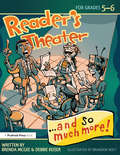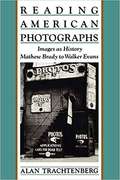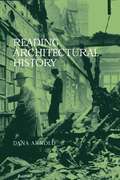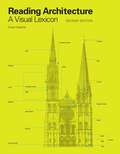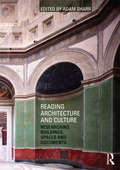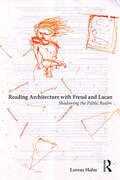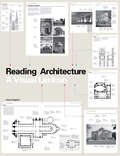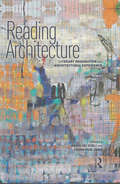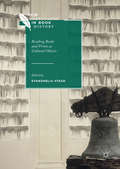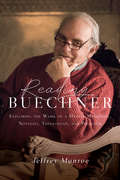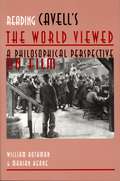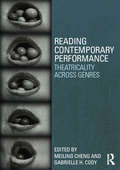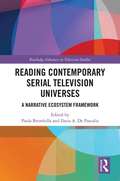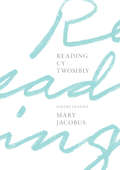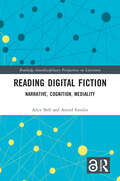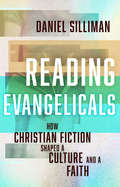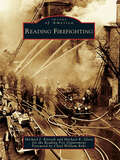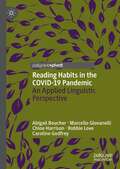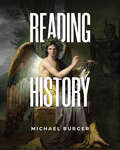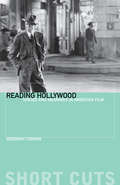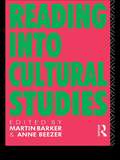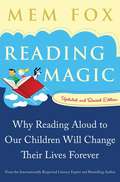- Table View
- List View
Reader's Theater...and So Much More!: Grades 5-6
by Brenda McGee Debbie Keiser TriskaReader's Theater . . . and So Much More! is written for grades 5-6. This exciting resource contains plays, skits, and independent research activities with an innovative twist for differentiated instruction. This high-interest book of humorous skits and plays is a jumping-off point for research and creativity for students of all ability levels. Each of the reader's theaters comes with suggestions for differentiating and extending the lesson's content. These plays not only provide a legitimate reason for students to reread texts and practice fluency, but they also promote cooperative interaction with peers.Grades 5-6
Reading About - My Home
by Jim PipeThe Reading About series introduces early readers to non-fiction. Each book is designed to increase reading fluency and combines a narrative text, accessible language and an easy-to-follow format.
Reading American Photographs: Images As History: Mathew Brady to Walker Evans
by Alan TrachtenbergIn this book, Alan Trachtenberg reinterprets some of America's most significant photographs, presenting them not as static images but rather as rich cultural texts suffused with meaning and historical content. Reading American Photographs is lavishly illustrated with the work of such luminaries as Mathew Brady, Timothy O'Sullivan, and Walker Evans--pictures that document the American experience from 1839 to 1938. In an outstanding analysis, Trachtenberg eloquently articulates how the art of photography has both followed and shaped the course of American history, and how images captured decades ago provocatively illuminate the present.
Reading Architectural History
by Dana ArnoldArchitectural history is more than just the study of buildings. Architecture of the past and present remains an essential emblem of a distinctive social system and set of cultural values and as a result it has been the subject of study of a variety of disciplines. But what is architectural history and how should we read it?Reading Architectural History examines the historiographic and socio/cultural implications of the mapping of British architectural history with particular reference to eighteenth - and nineteenth-century Britain. Discursive essays consider a range of writings from biographical and social histories to visual surveys and guidebooks to examine the narrative structures of histories of architecture and their impact on perception adn understanding of the architecture of the past. Alongside this, each chapter cites canonical histories juxtaposed with a range of social and cultural theorists, to reveal that these writings are richer than we have perhaps recognised and that architectural production in this period can in interrogated in the same way as that from more recent past - and can be read in a variety of ways. The essays and texts combine to form an essential course reader for methods and critical approached to architectural history, and more generally as examples of the kind of evidence used in the formation of architectural histories, while also offering a thematic introduction to architecture in Britain and its social and cultural meaning.
Reading Architecture Second Edition: A Visual Lexicon
by Owen HopkinsAnyone with an interest in buildings and the built environment would do well to purchase a copy of Owen Hopkins' book. - MonocleThis innovative and unique book is a visual guide to the buildings that surround us. Architectural features are pinpointed and labelled on images of buildings so that, unlike with other architectural dictionaries, you don't have to know the name before looking it up. Clear line drawings and extensive colour photographs illustrate each of the main building types, from forts to churches, stately homes to skyscrapers. The individual structural elements and materials common to all buildings are then explained, whether in Classical, Gothic or Modernist style. A comprehensive glossary completes the book. This revised edition includes an expanded section on modern structures and materials, as well as the latest styles and concepts from the last ten years. A must for all lovers of architecture and those who would like to learn moreOver 11,000 copies sold in English worldwide Covers all key building types and styles, from cathedrals to skyscrapers, Classical to contemporary. Each building type is illustrated with extensive photographs and annotated drawings Contains a comprehensive glossary of architectural terms
Reading Architecture Second Edition: A Visual Lexicon
by Owen HopkinsAnyone with an interest in buildings and the built environment would do well to purchase a copy of Owen Hopkins' book. - MonocleThis innovative and unique book is a visual guide to the buildings that surround us. Architectural features are pinpointed and labelled on images of buildings so that, unlike with other architectural dictionaries, you don't have to know the name before looking it up. Clear line drawings and extensive colour photographs illustrate each of the main building types, from forts to churches, stately homes to skyscrapers. The individual structural elements and materials common to all buildings are then explained, whether in Classical, Gothic or Modernist style. A comprehensive glossary completes the book. This revised edition includes an expanded section on modern structures and materials, as well as the latest styles and concepts from the last ten years. A must for all lovers of architecture and those who would like to learn moreOver 11,000 copies sold in English worldwide Covers all key building types and styles, from cathedrals to skyscrapers, Classical to contemporary. Each building type is illustrated with extensive photographs and annotated drawings Contains a comprehensive glossary of architectural terms
Reading Architecture and Culture: Researching Buildings, Spaces and Documents
by Adam SharrArchitecture displays the values involved in its inhabitation, construction, procurement and design. It traces the thinking of the individuals who have participated in it, their relationships, and their involvement in the cultures where they lived and worked. In this way, buildings, their details, and the documents used to make them, can be read closely for cultural insights. Introducing the idea of reading buildings as cultural artefacts, this book presents perceptive readings by eminent writers which demonstrate the power of this approach. The chapters show that close readings of architecture and its materials can test commonplace assumptions, help architects to appreciate the contexts in which they work, and indicate ways to think more astutely about design. The readings collected in this innovative and accessible book address buildings, specifications and photographs. They range in time from the fifteenth century – examining the only surviving drawing made by Leon Battista Alberti – to the recent past – projects completed by Norman Foster in 2006 and Herzog and De Meuron in 2008. They range geographically from France to Puerto Rico to Kazakhstan and they range in fame from buildings celebrated by critics to house extensions and motorway service areas. Taken together, these essays demonstrate important research methods which yield powerful insights for designers, critics and historians, and lessons for students.
Reading Architecture with Freud and Lacan: Shadowing the Public Realm
by Lorens HolmReading Architecture with Freud and Lacan: Shadowing the Public Realm methodically outlines key concepts in psychoanalytic discourse by reading them against key modern and post-modern architects. It begins with what is, arguably, the central concept for each discipline by putting the unconscious in a dialectic relation to space. Each subsequent chapter begins with a detail in architectural discourse, a kind of provocation that anchors each excursion into the thought of Freud and Lacan. The text is cyclical, episodic, and cloudlike rather than expository; the intention is not simply to explain the concept of the unconscious but, to different degrees, perform it in the text. The book offers powerful critiques of current planning practice, which has no tools to address our attachment to places. It concludes with powerful critiques of our incapacity to change the environmentally damaging ways we live our lives, which is an effect of our incapacity to recognise the presence of the death drive in our nature. The text is an extended thesis – spanning the chapters – that the field of the Other is the common grammar that organises subjects into civilisations, which has consequences for how we treat the public realm in architecture, politics, and the city. The field of the Other is a slightly different slice through the urban social world. It shadows – but does not correspond exactly to – more familiar categories like private/public, inside/outside, figure/ground, or piazza/boulevard. Reading Architecture with Freud and Lacan will be an essential resource to anyone interested in how the environment we build is a reflection of our desire. Psychoanalysis is one of the great humanist discourses of the 20th century and this book will be a valuable reference to the humanist in architects, planners, and social scientists, whether they are students, professionals, or amateurs. It will appeal to historians of the 20th century, and to psychoanalysts and architects who are interested in how their respective discourses interdigitate with each other and with other discourses.
Reading Architecture: A Visual Lexicon
by Owen HopkinsThis innovative and unique book is a visual guide to the buildings that surround us, naming all the visible architectural features so that, unlike other architectural dictionaries, the reader doesn't have to know the name before looking it up. Clear line drawings and extensive colour photographs illustrate each of the main building types, from forts to churches, stately homes to skyscrapers. The individual structural elements and materials common to all buildings are then explained, whether in Classical, Gothic or Modernist style, before delving into the inner architectural details such as doors and windows, roofs and staircases. A comprehensive glossary completes the book. An original and accessible take on the architectural dictionary, this book takes you on a visual tour of the buildings around us, and will be useful not only to students but to anyone with a general interest in architecture.
Reading Architecture: A Visual Lexicon
by Owen HopkinsThis innovative and unique book is a visual guide to the buildings that surround us, naming all the visible architectural features so that, unlike other architectural dictionaries, the reader doesn't have to know the name before looking it up. Clear line drawings and extensive colour photographs illustrate each of the main building types, from forts to churches, stately homes to skyscrapers. The individual structural elements and materials common to all buildings are then explained, whether in Classical, Gothic or Modernist style, before delving into the inner architectural details such as doors and windows, roofs and staircases. A comprehensive glossary completes the book. An original and accessible take on the architectural dictionary, this book takes you on a visual tour of the buildings around us, and will be useful not only to students but to anyone with a general interest in architecture.
Reading Architecture: Literary Imagination and Architectural Experience
by Angeliki Sioli Yoonchun JungWhy write instead of draw when it comes to architecture? Why rely on literary pieces instead of architectural treatises and writings when it comes to the of study buildings and urban environments? Why rely on literary techniques and accounts instead of architectural practices and analysis when it comes to academic research and educational projects? Why trust authors and writers instead of sociologists or scientists when it comes to planning for the future of cities? This book builds on the existing interdisciplinary bibliography on architecture and literature, but prioritizes literature’s capacity to talk about the lived experience of place and the premise that literary language can often express the inexpressible. It sheds light on the importance of a literary instead of a pictorial imagination for architects and it looks into four contemporary architectural subjects through a wide variety of literary works. Drawing on novels that engage cities from around the world, the book reveals aspects of urban space to which other means of architectural representation are blind. Whether through novels that employ historical buildings or sites interpreted through specific literary methods, it suggests a range of methodologies for contemporary architectural academic research. By exploring the power of narrative language in conveying the experience of lived space, it discusses its potential for architectural design and pedagogy. Questioning the massive architectural production of today’s globalized capital-driven world, it turns to literature for ways to understand, resist or suggest alternative paths for architectural practice. Despite literature’s fictional character, the essays of this volume reveal true dimensions of and for places beyond their historical, social and political reality; dimensions of utmost importance for architects, urban planners, historians and theoreticians nowadays.
Reading Books and Prints as Cultural Objects
by Evanghelia SteadThis book contributes significantly to book, image and media studies from an interdisciplinary, comparative point of view. Its broad perspective spans medieval manuscripts to e-readers. Inventive methodology offers numerous insights into visual, manuscript and print culture: material objects relate to meaning and reading processes; images and texts are examined in varied associations; the symbolic, representational and cultural agency of books and prints is brought forward. An introduction substantiates methods and approaches, ten chapters follow along media lines: from manuscripts to prints, printed books, and e-readers. Eleven contributors from six countries challenge the idea of a unified field, revealing the role of books and prints in transformation and circulation between varying cultural trends, 'high' and 'low'. Mostly Europe-based, the collection offers book and print professionals, academics and graduates, models for future research, imaginatively combining material culture with archival data, cultural and reading theories with historical patterns.
Reading Buechner: Exploring the Work of a Master Memoirist, Novelist, Theologian, and Preacher
by Jeffrey MunroeFrederick Buechner is one of the most gifted writers of his generation, and his legacy casts a long shadow over Christian letters today.
Reading Cavell's The World Viewed: A Philosophical Perspective on Film
by Marian Keane William RothmanIn their thoughtful study of one of Stanley Cavell's greatest yet most neglected books, William Rothman and Marian Keane address this eminent philosopher's many readers, from a variety of disciplines, who have neither understood why he has given film so much attention, nor grasped the place of The World Viewed within the totality of his writings about film. Rothman and Keane also reintroduce The World Viewed to the field of film studies. When the new field entered universities in the late 1960s, it predicated its legitimacy on the conviction that the medium's artistic achievements called for serious criticism and on the corollary conviction that no existing field was capable of the criticism filmed called for. The study of film needed to found itself, intellectually, upon a philosophical investigation of the conditions of the medium and art of film. Such was the challenge The World Viewed took upon itself. However, film studies opted to embrace theory as a higher authority than our experiences of movies, divorcing itself from the philosophical perspective of self-reflection apart from which, The World Viewed teaches, we cannot know what movies mean, or what they are. Rotham and Keane now argue that the poststructuralist theories that dominated film studies for a quarter of a century no longer compel conviction, Cavell's brilliant and beautiful book can provide a sense of liberation to a field that has forsaken its original calling. read in a way that acknowledges its philosophical achievement, The World Viewed can show the field a way to move forward by rediscovering its passion for the art of film. Reading Cavell's The World Viewed will prove invaluable to scholars and students of film and philosophy, and to those in other fields, such as literary studies and American studies, who have found Cavell's work provocative and fruitful.
Reading Contemporary Performance: Theatricality Across Genres
by Meiling Cheng Gabrielle H. CodyAs the nature of contemporary performance continues to expand into new forms, genres and media, it requires an increasingly diverse vocabulary. Reading Contemporary Performance provides students, critics and creators with a rich understanding of the key terms and ideas that are central to any discussion of this evolving theatricality. Specially commissioned entries from a wealth of contributors map out the many and varied ways of discussing performance in all of its forms – from theatrical and site-specific performances to live and New Media art. The book is divided into two sections: Concepts - Key terms and ideas arranged according to the five characteristic elements of performance art: time; space; action; performer; audience. Methodologies and Turning Points - The seminal theories and ways of reading performance, such as postmodernism, epic theatre, feminisms, happenings and animal studies. Case Studies – entries in both sections are accompanied by short studies of specific performances and events, demonstrating creative examples of the ideas and issues in question. Three different introductory essays provide multiple entry points into the discussion of contemporary performance, and cross-references for each entry also allow the plotting of one’s own pathway. Reading Contemporary Performance is an invaluable guide, providing not just a solid set of familiarities, but an exploration and contextualisation of this broad and vital field.
Reading Contemporary Serial Television Universes: A Narrative Ecosystem Framework (Routledge Advances in Television Studies)
by Paola Brembilla Ilaria A. De PascalisReading Contemporary Serial Television Universes provides a new framework—the metaphor of the narrative ecosystem—for the analysis of serial television narratives. Contributors use this metaphor to address the ever-expanding and evolving structure of narratives far beyond their usual spatial and temporal borders, in general and in reference to specific series. Other scholarly approaches consider each narrative as composed of modular elements, which combine to create a bigger picture. The narrative ecosystem approach, on the other hand, argues that each portion of the narrative world contains all of the main elements that characterize the world as a whole, such as narrative tensions, production structures, creative dynamics and functions. The volume details the implications of the narrative ecosystem for narrative theory and the study of seriality, audiences and fandoms, production, and the analysis of the products themselves.
Reading Cy Twombly: Poetry in Paint
by Mary JacobusMany of Cy Twombly's paintings and drawings include handwritten words and phrases--naming or quoting poets ranging from Sappho, Homer, and Virgil to Mallarmé, Rilke, and Cavafy. Enigmatic and sometimes hard to decipher, these inscriptions are a distinctive feature of his work. Reading Cy Twombly poses both literary and art historical questions. How does poetic reference in largely abstract works affect their interpretation?Reading Cy Twombly is the first book to focus specifically on the artist's use of poetry. Twombly's library formed an extension of his studio and he sometimes painted with a book open in front of him. Drawing on original research in an archive that includes his paint-stained and annotated books, Mary Jacobus's account--richly illustrated with more than 125 color and black-and-white images--unlocks an important aspect of Twombly's practice.Jacobus shows that poetry was an indispensable source of reference throughout Twombly's career; as he said, he "never really separated painting and literature." Among much else, she explores the influence of Ezra Pound and Charles Olson; Twombly's fondness for Greek pastoral poetry and Virgil's Eclogues; the inspiration of the Iliad and Ovid's Metamorphoses; and Twombly's love of Keats and his collaboration with Octavio Paz.Twombly's art reveals both his distinctive relationship to poetry and his use of quotation to solve formal problems. A modern painter, he belongs in a critical tradition that goes back, by way of Roland Barthes, to Baudelaire. Reading Cy Twombly opens up fascinating new readings of some of the most important paintings and drawings of the twentieth century.
Reading Digital Fiction: Narrative, Cognition, Mediality (Routledge Interdisciplinary Perspectives on Literature)
by Astrid Ensslin Alice BellReading Digital Fiction offers the first comprehensive and systematic theoretical, methodological, and analytical examination of digital fiction from a cognitive and empirical perspective. Proposing the new concept of “medial reading”, it argues for the centrality of an audience’s interest in, awareness of and/or attention to the medium in which a text is produced and received, and which we argue should be applied to reader data across media. The book analyses and theorises five generations of digital fiction and their reading including hypertext fiction, hypermedia fiction, narrative video games, app fiction, and virtual reality. It showcases medium- and platform-specific methods of qualitative reader response research across a variety of contexts and settings from screen-based and embodied interaction to gallery installation, and from reading group and individual interview to think-aloud methodologies. The book thus addresses the unique affordances of digital fiction reading by designing and reporting on new empirical studies focusing on hypertextuality, interactivity, immersion, as well as medium-specific forms of textual “you”, ontological ambiguity, reader orientation and empathy. In so doing, the book refines, critiques, and expands cognitive, transmedial, and empirical narratology and stylistics by placing the reader of these new narratives front and centre.The Open Access version of this book, available at http://www.taylorfrancis.com, has been made available under a Creative Commons [Attribution-Non Commercial-No Derivatives (CC-BY-NC-ND)] 4.0 license.
Reading Evangelicals: How Christian Fiction Shaped a Culture and a Faith
by Daniel SillimanThe story of five best-selling novels beloved by evangelicals, the book industry they built, and the collective imagination they shaped Who are evangelicals? And what is evangelicalism? Those attempting to answer these questions usually speak in terms of political and theological stances. But those stances emerge from an evangelical world with its own institutions—institutions that shape imagination as much as they shape ideology. In this unique exploration of evangelical subculture, Daniel Silliman shows readers how Christian fiction, and the empire of Christian publishing and bookselling it helped build, is key to understanding the formation of evangelical identity. With a close look at five best-selling novels—Love Comes Softly, This Present Darkness, Left Behind, The Shunning, and The Shack—Silliman considers what it was in these books that held such appeal and what effect their widespread popularity had on the evangelical imagination. Reading Evangelicals ultimately makes the case that the worlds created in these novels reflected and shaped the world evangelicals saw themselves living in—one in which romantic love intertwines with divine love, humans play an active role in the cosmic contest between angels and demons, and the material world is infused with the literal workings of God and Satan. Silliman tells the story of how the Christian publishing industry marketed these ideas as much as they marketed books, and how, during the era of the Christian bookstore, this—every bit as much as politics or theology—became a locus of evangelical identity.
Reading Firefighting (Images of America)
by Michael R. Glore Michael J. Kitsock Chief William Rehr Reading Fire DepartmentFrom its inception in Colonial times to the modern challenges of today, the Reading Fire Department has battled natural disasters, airplane crashes, and block burners threatening "the Pretzel City." The fire department has faithfully served the city of Reading since 1771, having been established soon after Benjamin Franklin organized the nation's first volunteer fire department in Philadelphia. At one time the Reading Fire Department even boasted the largest all-volunteer fire department in the nation, consisting of more than 10,000 volunteer members operating from 14 fire stations throughout the city. Using the archives of the Reading Fire Department, the Reading Eagle, and the Historical Society of Berks County, Reading Firefighting documents the history and traditions of this dedicated fire department.
Reading Habits in the COVID-19 Pandemic: An Applied Linguistic Perspective
by Marcello Giovanelli Robbie Love Chloe Harrison Abigail Boucher Caroline GodfreyThis book presents and analyses the results of the Lockdown Library Project survey, using a range of quantitative and qualitative approaches to provide a unique insight into the ways in which the first UK COVID-19 lockdown affected public reading habits. The authors begin by outlining the background to the study, the research methodology and design, and an overview of the headlines of the data, before going on to survey the literature on the relationship between pandemics, literature (especially the role played by genre and popular fiction) and reading habits. They then examine how participants reported that the lockdown period had affected the amount that they read; how they accessed books and discussed their reading with others; the use of reading as a coping strategy; and returning to re-read books that offered familiarity, reliability, and nostalgia. Finally, the concluding chapter brings together the overall findings of the project and briefly outlines future work in the field. This book will be of interest to academics in fields such as literary and genre studies, applied linguistics, corpus linguistics, stylistics, health humanities, and sociology, as well as practitioners working in education, in bibliotherapy, and in libraries.
Reading History
by Michael BurgerHistory students read a lot. They read primary sources. They read specialized articles and monographs. They sometimes read popular histories. And they read textbooks. Yet students are beginners, and as beginners they need to learn the differences among various kinds of readings – their natures, their challenges, and the unique expectations one needs to bring to each of them. Reading History is a practical guide to help students read better. Uniquely designed with the author’s engaging explanations in the margins, the book describes primary sources across various genres, including documents of practice, treatises, and literary works, as well as secondary sources such as textbooks, articles, and monographs. An appendix contains tips and questions for reading primary or secondary sources. Full of practical advice and hands-on training that allows students to be successful, Reading History will cultivate a wider appreciation for the discipline of history.
Reading Hollywood: Spaces and Meanings in American Film (Short Cuts)
by Deborah ThomasThis book examines the treatment of space and narrative in a selection of classic films including My Darling Clementine, It's a Wonderful Life, and Vertigo. Deborah Thomas employs a variety of arguments in exploring the reading of space and its meaning in Hollywood cinema and film generally. Topics covered include the importance of space in defining genre (such as the necessity of an urban landscape for a gangster film to be a gangster film); the ambiguity of offscreen space and spectatorship (how an audience reads an unseen but inferred setting), and the use of spatially disruptive cinematic techniques such as flashback to construct meaning.
Reading Into Cultural Studies
by Martin Barker Anne Beezer"Reading Into Cultural Studies" revisits a selection of key texts central to the formation of cultural studies as a discipline and as a project. These texts address questions of power, ideology and the possibilities and limits of resistance. Each of the eleven essays in the collection renews an early study in one area of cultural investigation, bringing such seminal texts as "Subculture" by Dick Hebdige, "Loving With a Vengeance" by Tania Modleski and "Bond and Beyond" by Tony Bennett back to the centre of attention, However the essays are not purely celebratory. Each study is critically examined in a number of ways - for its research strategy, its implicit theories of power and ideology, for the empirical evidence it draws on and its conceptual framework. Together, the essays provide an introduction to some of the central debates and issues in cultural studies.
Reading Magic: Why Reading Aloud to Our Children Will Change Their Lives Forever
by Mem FoxWith passion and humor, Fox speaks of when, where, and why to read aloud and demonstrates how to read aloud to best effect and get the most out of a read-aloud session. She discusses the three secrets of reading, offers guidance on defining and choosing good books.
